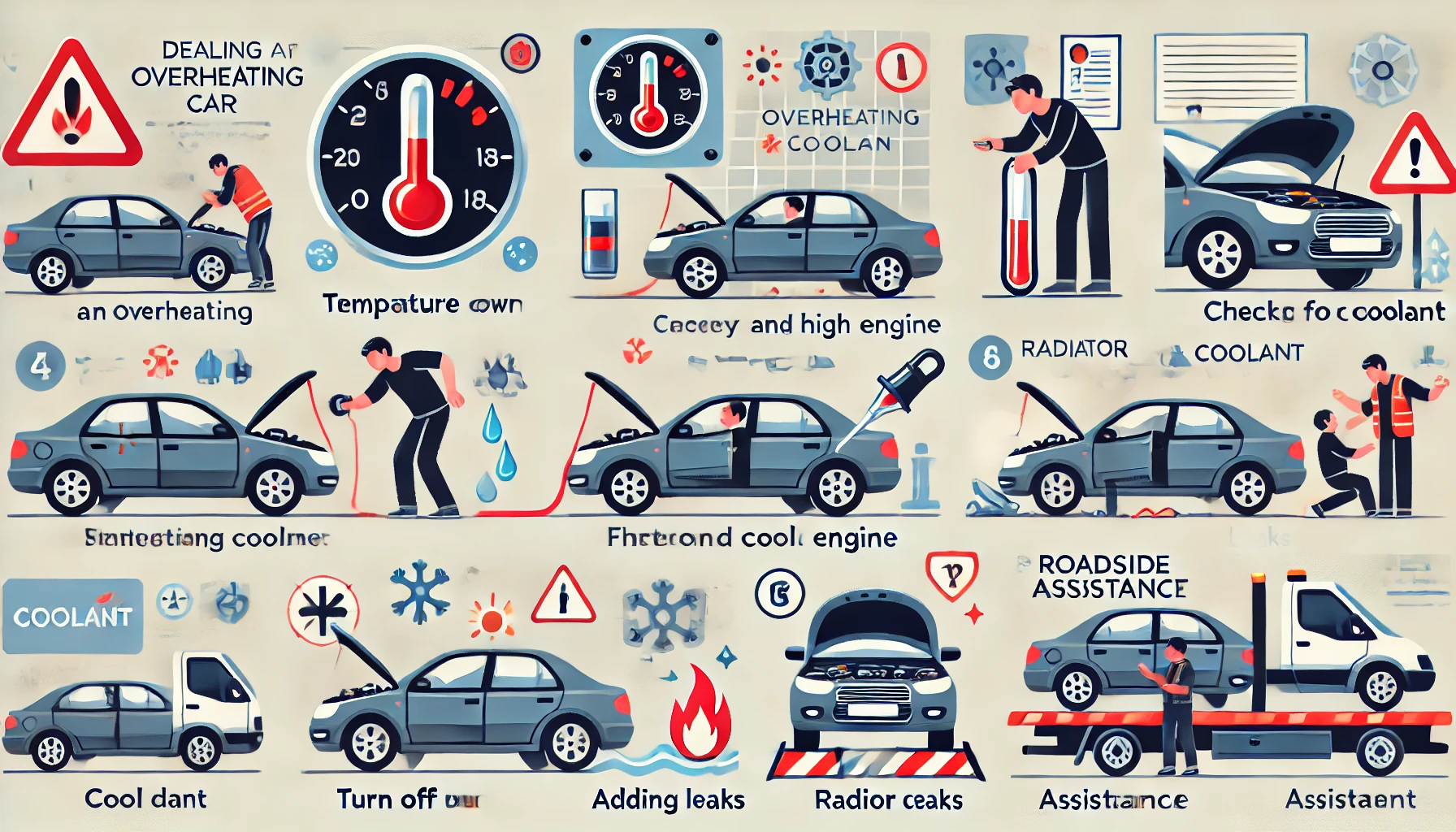Car overheating is one of the most concerning situations a driver can face. The engine temperature rising beyond normal limits can cause serious damage if not addressed promptly. Fortunately, there are several steps you can take to handle an overheating car safely. Here’s a detailed step-by-step guide on what to do when your car overheats.
1. Recognize the Signs of Overheating
The first step in managing an overheating car is identifying the problem early. Here are the common signs of overheating:
- Warning Lights/Temperature Gauge: Your car’s temperature gauge will show when the engine runs hotter than usual. Some vehicles also have a dedicated warning light for engine temperature.
- Steam or Smoke: Steam or smoke coming from under the hood is a clear indication that the engine is overheating significantly.
- Unusual Smells: A sweet, burnt, or unusual smell
can indicate that the coolant is leaking or that the engine components are overheating.
2. Pull Over Safely
If you notice any of the above signs while driving, the next step is to pull over to a safe location. Find a flat area away from traffic to stop and park your vehicle. It’s crucial to stop driving immediately to prevent further damage to your engine. Continuing to drive an overheating car can lead to catastrophic engine failure.
3. Turn Off the Engine
Once you’ve pulled over and stopped the car, turn off the engine immediately. This is essential because the engine’s temperature will continue to rise while it’s running, and keeping it on could cause more severe damage, such as warped cylinder heads or a blown head gasket.
4. Let the Engine Cool Down
Before you open the hood or do anything else, you need to let the engine cool down. Ideally, wait for at least 15-30 minutes to allow the temperature to drop. This step is important for your safety to avoid burns from hot components. During this time, the pressure inside the cooling system will also decrease.
5. Check the Coolant Level
After waiting for the engine to cool, the next step is to check the coolant level. Inspect the radiator coolant reservoir to see if it’s empty or low. If it is, this is a likely cause of the overheating issue. However, do not open the radiator cap until the engine is completely cool—hot coolant can spray out under pressure, causing serious burns.
6. Add Coolant or Water
If the coolant level is low, add coolant to the radiator or the coolant reservoir. Coolant is preferable because it’s designed to regulate engine temperature and prevent freezing. If you don’t have coolant, you can use water temporarily. But remember, water isn’t ideal for long-term use as it can cause rust and lower the cooling efficiency.
7. Inspect for Leaks
After topping up the coolant, check for any signs of coolant leaks. Look under the car to see if there is a puddle of coolant on the ground. If you spot a leak, you will likely need professional help to repair it. If no leak is visible, continue with the next steps.
8. Check for Other Potential Problems
Overheating can occur for various reasons, and it’s important to check for other issues:
- Radiator Cap: A damaged radiator cap may fail to maintain proper pressure, leading to overheating. replace the cap in this case immediately.
- Thermostat Failure: A stuck thermostat can block coolant from circulating, preventing your engine from cooling down. If this is suspected, the thermostat may need to be replaced.
- Broken Fan or Water Pump: The cooling system relies on a functioning fan and water pump. If either of these components fails, it can lead to overheating. Listen for unusual noises or check if the fan is working when the engine starts.
- Clogged Radiator: Dirt or debris can clog the radiator, limiting coolant flow. Check to ensure the radiator fins are clear.
9. Restart the Engine (After Cooling)
Once the coolant has been added and you’ve checked for leaks, start the engine again. Keep an eye on the temperature gauge to see if it stabilizes. If the engine temperature begins to rise again or remains high, there could be a more serious underlying issue that needs professional attention.
10. Drive to a Safe Location
If the engine temperature appears to be stable after you’ve added coolant, you can cautiously drive to a nearby mechanic or repair shop. However, avoid driving for long distances or in heavy traffic. Keep monitoring the temperature gauge to ensure the issue does not reoccur.
11. When to Call for Roadside Assistance
In some cases, the problem may be beyond your ability to fix. Call for roadside assistance if:
- The car continues to overheat even after adding coolant.
- There are visible leaks you can’t repair.
- The engine temperature remains high despite cooling efforts. Roadside assistance can help you get the car to a repair shop or provide a tow service to avoid further damage.
Preventive Measures: How to Avoid Overheating in the Future
Preventing overheating is key to avoiding costly engine repairs. Here are some tips to keep your car’s engine running at the right temperature:
- Regularly check and change the coolant according to the manufacturer’s maintenance schedule.
- Inspect the radiator, hoses, and belts for signs of wear or damage.
- Make Sure that the thermostat and the water pump are working as expected.
- Keep the radiator and cooling fans free from dirt and debris to maintain proper airflow.
Final Words
Dealing with an overheating car can be stressful, but by following these simple steps, you can manage the situation safely and effectively. Always remember that prevention is the best strategy, and regular maintenance is crucial to avoiding engine overheating. If you encounter repeated overheating problems, it’s best to consult with a professional mechanic to prevent further damage to your engine.

Leave a Reply